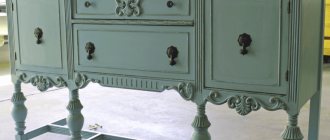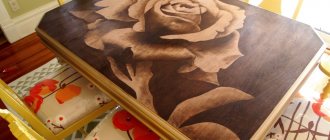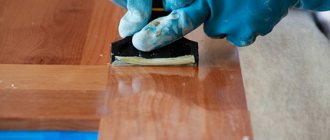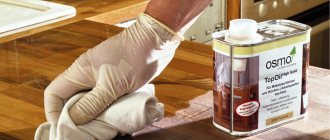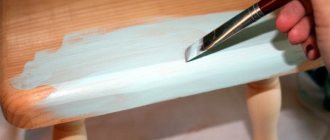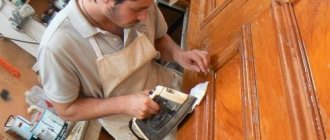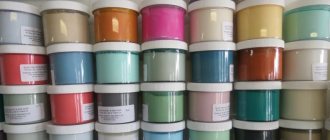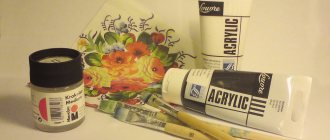Wooden furniture is incredibly popular among users. It is made from environmentally friendly, natural material, smells pleasant, and lasts a long time. No less practical, but inexpensive are products made from chipboard, laminate, MDF and other combined bases.
Despite its strength, any furniture deteriorates over time, wears out, and loses its attractiveness. To update its appearance and extend its service life, furniture wax has been developed - a universal composition that hides minor defects and protects surfaces from moisture.
Types and uses of furniture wax for scratches
Wooden furniture is in particular demand among consumers.
Its demand is explained by the harmlessness, durability and beauty of the material, but over time, scratches, cracks, and chips may appear on the surface, which upset the owners. There are many effective means to eliminate such defects, one of which is furniture wax. When used correctly, it protects wood from moisture and perfectly hides furniture defects.
- Application
- Types Soft
- Solid
- Liquid
How to use wax pencil for furniture
Some problems require a special solution. If the place for restoration is difficult to access or requires small tools, then a special wax pencil will be required. The question arises - where to buy such a pencil for furniture? You can purchase it in hardware stores and construction supermarkets, but if such outlets are not available in your locality, you can always use online stores.
How to use a furniture pencil? Before use, warm it with the warmth of your hand, and then rub it into the desired place without strong pressure.
Types of furniture wax
Mixtures are divided into the following types:
Soft wax makes wood surfaces smooth and provides the desired shade to the wood texture.
This wax is preheated to make the wood material softer and the application better.
All corners, threads, chamfers are impregnated with this wax with maximum efficiency.
Soft is used if you want to update the appearance of furniture and give it a more attractive appearance, remove minor scratches and small cracks, repair shallow dents and chips.
This type of product is quite easy to use.
Before applying it, it is necessary to prepare the area for treatment - wipe it dry, remove any remaining paint or varnish, if any. Then the product is applied by rubbing in the required amount and left for 25 minutes.
The main advantage of this coating is that the wax penetrates the wood rather than remaining on the surface.
The excess is removed with a knife, and the treated area is polished with a felt rag or cotton napkin. If the scratches are significant, the holding time can be increased.
This type has a richer palette of colors than the solid type.
Hard wax performs the same restoration functions as soft wax, but this material gives a greater effect in eliminating deep damage due to its thicker and denser consistency. The best aesthetic effect from the use of solid material is achieved due to its advantages such as high strength and resistance to mechanical stress.
This coating is indestructible even after many years.
It is more troublesome to use, but it perfectly restores serious flaws. Before applying, it must be melted and cooled for a few seconds for better adhesion. If necessary, remove excess with a knife and wipe with a napkin.
The cost of this type of mixture is always higher than the soft one, and it is not always easy to find on the open market.
The composition of liquid wax uses synthetic additives, thanks to which the required liquid consistency is achieved. The advantage of this type is the ease of application with a brush, penetration into any cracks and scratches.
Liquid wax is applied and dries in minimal time. Just a couple of hours – and the furniture is almost ready for use!
Restoration wax can be found in the form of paste-like, creamy or oil-like mixtures, differing in composition, consistency, method of application and nature of damage (scratch depth, etc.).
Why do you need to wax wood?
The bee product has the priority right to be called wax. The rest of the products are artificial products of the chemical industry. Furniture and any wooden surfaces are subject to various physical impacts. This can cause minor damage (scratches, cracks) and lead to loss of presentation. Wood tends to release vapors from the internal structure of the material into the atmosphere, which causes cracks and drying out.
Since ancient times, people have polished floors and furniture with beeswax. A layer of greasy product masked small cracks and prevented the depletion of the wood mass due to evaporation. The process of treating surfaces with wax is called waxing. For many decades there has been an increase in the need for bee products, which have become scarce. As a result, new compositions were invented that were superior in properties to natural wax.
Rules of application
Short rules will help an amateur use furniture wax correctly and complete restoration work without errors:
- Surface preparation. For uniform impregnation, the pores of the wood must be open. If the furniture is factory-made and not covered with paint and varnish, then no preparation is required. If the surface is varnished, then to remove the top layer you will need the help of a solvent. They should treat the surface several times until the remaining varnish is removed. It is necessary to go through the direction of the fibers with sanding material.
- Applying wax. First you need to decide on the variety. The preparation of the necessary tools for the job depends on this. The soft look is rubbed in the direction of the wood grain using a thick cloth. If the choice fell on the hard type, then a spatula will be required to evenly rub into the surface. After applying the composition, the structure should be left alone for an hour. Then the excess wax mass is removed. To achieve a glossy effect, treat the wooden layer again.
Wax mixtures
Impregnating wood with wax in its pure form is the first thing that comes to the mind of a home craftsman. The instructions themselves are extremely simple and look something like this:
| Illustrations | Recommendations |
| Preparation. We will be processing a kitchen knife stand. · Natural beeswax is used as the main composition (it is better to buy it on the market from beekeepers or honey merchants); · We will apply with a brush with natural bristles; · For warming up, it is advisable to have a hair dryer, but you can get by with a household one; · From the dishes you will need a saucepan and a jar for wax. | |
| Warming up the wax. Natural beeswax melts at a temperature of 62 - 70ºС, but it must be melted in a water bath, otherwise it will darken (burn). · Pour water into a saucepan and place it on the stove; · Place some kind of stand or just a rag on the bottom of the pan; · Place wax in a jar, immerse the jar in a saucepan and wait until the wax melts. | |
| Waxing. In order for the heated, liquid wax for wood to be well absorbed into this very wood, the workpiece also needs to be heated. The easiest way is to heat the wooden blank in the oven; this can be done while the wax is melting. Then take a brush and “paint” the workpiece with wax. | |
| Finishing. It is not realistic to apply wax evenly with a brush; as the composition cools, the thickness of the layer will increase, so after application, excess wax must be scraped off the workpiece. For work, you can take a plastic card; it is not advisable to use a knife, as you can scratch the surface. Next, take a hairdryer, point it at the workpiece and rub the heated surface with a cotton cloth. |
Remember the rule common to all recipes: hard wax is never used for cosmetic treatment, much less wood impregnation! The composition should be liquid or paste-like, but not solid.
The above method is good, but it has a number of serious disadvantages:
- The wax hardens quickly and if you have to cover something bulky, for example, furniture, the wax will need to be constantly heated, plus a lot of hassle with cleaning the workpiece after application;
- No matter how you try to rub the workpiece with a rag or felt, you will never achieve shine; the surface will remain matte;
- If you don’t take care of a waxed item, it will become covered with dust and this dust will become ingrained. To restore its original appearance, you will have to repeat the entire cycle again, that is: sand it with sandpaper, cover it with hot wax and rub it.
To call the procedure outlined above a recipe is somehow hard to come by; it’s more of an application technology, I talked about it so that you have an idea of the basics, and now we move on to specific recipes.
Recipe No. 1. Designed for processing furniture
For furniture, the problem of ingrained dust is relevant, no matter how you wipe your furniture, but over time, a coating will still appear on clean wax. To avoid this problem and at the same time not lose in naturalness and quality, our wise people came up with the idea of mixing hot wax with rosin.
Recipe for wax impregnation for furniture.
Rosin acts as a crystallizer and promotes the formation of a durable film on the surface, while the wood will breathe. Turpentine is added as a solvent; it will prevent the mixture from hardening quickly and you will have time to easily treat the surface.
The composition is prepared in a water bath, the sequence of actions is approximately as follows:
- Beeswax is heated to a liquid state first;
- When about half the volume of wax has melted, you can add rosin, and it is advisable to crush the rosin;
- After the wax and rosin are completely dissolved, turpentine is added to the composition and the whole thing is thoroughly mixed.
For interior work, I recommend using gum turpentine; its price is slightly higher, but it stinks less.
The furniture processing technology is slightly different from the option described above.
- In this case, after applying the finished composition, you leave the item alone for 3 hours;
- Next, take a hair dryer and heat the surface, wipe off the excess mixture from it and again let the workpiece cool for another hour;
- At the third stage, with light heating, you actively polish the workpiece; you will not achieve a mirror shine, but you will undoubtedly get a noble sheen.
Wax with rosin and pure wax for wooden floors or walls can theoretically be used, but oil wax is better suited here, which I will talk about a little later, in the corresponding chapter of this article.
Recipe No. 2. Inexpensive exterior decoration
Natural beeswax is very expensive to use for exterior work, plus there is no particular need for a 100% natural impregnation on the outside of a building. Instead of wax, it will be much cheaper to take regular white or some other paraffin.
Inexpensive paraffin impregnation for outdoor use.
Ideally, instead of gasoline, it is better to use purified acetone; it, of course, is more expensive, but the smell disappears much faster. It is also better to take gasoline as pure as possible.
And don’t forget - both acetone and gasoline are flammable liquids. It is generally better to cook large volumes in air, otherwise in a closed room the vapors at high concentrations can explode from any spark.
Benefits of wax
Using wax for restoration work is beneficial due to the properties of the substance, which penetrates deeply into the structure of the wood, strengthens it and subsequently protects it from mechanical damage and moisture. Applying a layer of wax ointment to the furniture will give the product a renewed look and the natural richness of the color of living wood. With a varied palette of colors, you can match the crayons to any tree or change the shade to another if necessary. Wax crayons are an inexpensive but effective tool that helps in solving a wide range of repair tasks and gives a new chance to furniture that has lost its former attractiveness.
How to choose the right one
The choice of restoration product depends on the color, type and composition. The color palette is quite impressive.
Finding a suitable color will not be difficult.
Almost all types are based on the same composition containing natural substances:
- Wax (beeswax or carnauba);
- Oils (olive, linseed, etc.);
- Coniferous esters;
- Wood resin;
- Drying oil.
To give the required consistency and properties, artificial solvents, UV filters and other additives are added.
The choice of consistency depends on the area of the damaged surface and the depth of the cracks. Liquid wax is suitable for shallow multiple scratches.
It is better to choose a solid mixture if the chips and cracks are large and require careful restoration.
Apply the wax by simply pressing it into the surface and then rub it with a spatula.
Soft is valued for its rich color palette and ease of use.
The color is quite stable and will not fade over time.
Wax comes in different forms. To remove minor damage, it will be convenient to purchase a wax pencil.
Wax pencil is the simplest and most economical solution for furniture restoration.
To process a large area, it is better to purchase bulk containers.
Instructions for use
To work with a soft composition, you will need a rubber spatula, felt, and to open the package - a sharp knife. First, prepare the surface so that it is clean and the pores of the wood are open.
The defective area is cleaned of varnish (if it was previously applied) using a solvent, washed to remove dirt, and completely dried. To improve the absorbency of the composition, go over the base with sandpaper (in the direction of the fibers of the material).
Then proceed like this:
- open the wax package;
- scoop up the product with a small spatula;
- apply the composition to the damaged area, sealing the crack or scratch;
- rub the material with felt;
- the excess is carefully cleaned off with the same spatula or knife;
- leave the product to dry for an hour;
- polish the surface again to give it a glossy finish.
As a rule, a scratch is treated with hard wax in the form of a pencil without prior preparation. Some products involve preliminary melting and subsequent infusion into a crack or other defect. In this case, you will need a soldering iron or a hair dryer to work. If you don’t have such tools, you can use a gas torch or lighter. The heated material is applied to the problem area, leveled with a spatula, and after drying, polished with a soft cloth. Excess composition is removed with a blunt knife.
Conditions for storing and using the wax product
Like any substance, wax impregnation made from natural organic components has a limited shelf life. For proper use and storage of wax polish, the following conditions must be observed:
- The shelf life of herbal impregnations in sealed containers is usually no more than 2 years.
- Store the wax product in a dark, cool place.
- The heated product is used to create a moisture-resistant, durable layer of wood finishing.
- The hardened mastic is used for polishing and glossing floors and furniture.
- A little solvent is added to the solid composition. The liquefied substance is applied with a brush, roller, then rubbed with a cloth or velvet rag.
- Before processing wooden products, remove the old wax coating. To do this, use solvents and zero-grade sandpaper.
- When working with a brush, you need to direct the fleecy bristles along the fibers of the wood structure.
- In order to give the treated area a certain shade, the appropriate color is added to the impregnation.
- If the impregnating agent dries slowly, a substance such as a drier is added to it. It can be purchased at art stores. The liquid acts as an accelerator for the polymerization of mastic and an antifungal agent.
Varieties
Today, you can find two types of furniture chalk on sale in hardware stores: solid and liquid. Each of them has a number of advantages and disadvantages, as well as different methods of use. To figure out which option to choose for your home, we suggest studying the summary table for the two types of crayons.
| Wax type | Purpose | Nuances of use | pros | Minuses |
| Soft | Repairing chips, cracks, scratches and other defects on horizontal wooden surfaces. Suitable for sealing marks from self-tapping screws and broken corners of the table top. | Apply with a spatula, after which the excess is removed with a felt disc. Ideal for filling large and deep surface voids. | Easy to use, available and sold in any store. | Not suitable for processing furniture that will subsequently be exposed to chemicals and ultraviolet radiation. |
| Solid | Repairing scratches and chips on doors, windows, and wooden interior items. | It is necessary to use solid furniture wax only in molten form. | High degree of protection against mechanical damage and temperature. | Difficult to find on sale, high cost, poor color palette. |
It is worth highlighting liquid wax separately, which is applied to the surface of the products using a small spatula. Its disadvantage is that it cannot be used on vertical planes. In consistency, it resembles drying oil - this mixture is achieved by the presence of synthetic substances and solvents. Its advantage is that the material penetrates holes of any diameter and depth, filling the gaps.
To use the solid type, a wax melter is used, which allows you to soften the structure of the substance, preparing it for work. This can also be achieved without special devices, for example, using a household hair dryer.
Today you can find the product on sale in several forms: wax crayons, as well as jars with a liquid composition. If wax will be used at home occasionally, it is better to take a wax pencil.
Waxing process
To wax wood surfaces you will need:
- wax preparation;
- brushes with different bristle hardness;
- solvent;
- grinding machine with emery and grinding wheels;
- polishing sandpaper;
- construction knife.
Operating procedure
- Without lingering on the damaged areas, use a sander to remove the surface layer over the entire area of the wood.
- To restore old parquet, large wide-format sanding machines are used.
- The cleaned surfaces are brought to complete cleanliness, removing minor defects with a construction knife or chisel.
- For waxing, use brushes of the required hardness, depending on the density of the product. The waxy substance is applied with a brush to the surface of the products, achieving uniform distribution of the composition. For large areas, use a roller.
- For final processing, the surface is ground with a velvet wheel until the desired degree of gloss is obtained.
Tips for preserving waxed furniture and hardwood floors
- it is necessary to regularly inspect the treated areas in order to detect violations of the integrity of the wax layer;
- prevent dust and contamination of the coating;
- in case of liquid spillage, you need to carefully remove the moisture with a soft cloth;
- do not delay the restoration of damaged waxed areas of wood, eliminate processing defects in a timely manner.
Basic properties and purpose
Modern cabinets and chests of drawers are subject to mechanical damage as a result of numerous moves and rearrangements, tables lose their attractiveness due to careless handling, so furniture wax remains in demand for minor repairs and care of products made of natural wood, laminate, parquet, chipboard and fiberboard. It is also suitable for repairing chips and cracks in window frames and doors. Furniture wax is used to treat panels, picture frames, wooden boxes and stair railings.
In addition to beeswax, the composition may contain synthetic resins, which give it greater durability, coloring pigment, and natural oils (for example, olive or linseed). Oil with wax provides light protection from moisture and a pleasant matte shine to wooden elements. The main purpose of the product is the renewal and restoration of products. A properly selected composition performs several functions at once:
- masks chips, scratches, small cracks;
- renews the surface of products, adding shine to them and emphasizing the texture of the wood;
- protects furniture from external influences, penetrating deeply into the structure of the material;
- used to enhance or slightly change the shade of wood;
- has antistatic properties, prevents dust from settling.
Products based on natural wax are very gentle on the texture of wood. They cannot radically change the color; they simply renew even heavily worn surfaces and give them a presentable appearance.
Manufacturers offer furniture wax for interior and exterior use; this should be taken into account when choosing a composition.
Varieties for interior use are less resistant to sunlight and moisture. The products differ in the form of release; it can be a hard bar, a pencil, or soft compositions with a texture reminiscent of Vaseline. Furniture wax can be colorless or tinted. In the second case, its shade should be as close as possible to the color of the surface being treated.
Composition of furniture oil
In the West, the main trend has long been the desire for environmental friendliness of the compositions used in construction: the days when walls were covered with “Paris green” and other compounds of lead and arsenic are gone forever. Following the opinion of consumers, legislation followed: EU standards established a limit value for the content of volatile organic substances - 400 g/l, and the use of polyurethane compounds for interior work was also sharply reduced (standard 2010).
Homemade and specialized formulations
We have already written about why you should not treat wood with homemade compounds. We can only say once again - you should not use used machine oil, drying oil, etc. for processing wood, especially indoors.
It may be possible to make gold and the philosopher’s stone, but it’s unlikely to be a good impregnation for wood.
Let's look at the composition of furniture oil G-Nature 225. It includes:
Flaxseed oil is a natural product obtained from flax seeds. Dries quickly due to the content of unsaturated fatty acids - oleic, linoleic and linolenic.
Wood (tung) oil is a product obtained by processing the seeds of the tung tree. The composition of the oil is unsaturated eleostearic acid, due to which the oil penetrates deeply into the wood.
Safflower oil is a vegetable oil made from the seeds of the safflower plant. It contains about 80% linoleic acid. This transparent oil is used to make colorless drying oils.
Beeswax is a waste product of bees, consisting of esters, fatty acids and polyhydric alcohols. Used to produce wood polishes.
Bentonite is a natural mineral (a complex compound of aluminum) used to purify oils, including sunflower.
Silica is known to everyone as ordinary sand. Amorphous silicon dioxide in oil is used to thicken the composition, due to its high oil absorption (300–340 g/100 g).
Zinc oxide – used as a drying agent. It is worth noting that in this capacity it is used in toothpastes and sunscreens - there is no smell of “scary chemicals” here.
Drying agents are additional substances that are added to the composition to speed up the drying of the oil. Most often these are salts of organic carboxylic acids.
Features of varieties
Furniture wax of soft and hard grades has its own characteristics.
Soft
Use it to get rid of scratches, chips, cracks and dents. Even if there are large broken edges or holes from self-tapping screws, this remedy will be effective.
In order to apply it yourself, you must follow these recommendations:
- To restore objects, the product must be rubbed in thoroughly.
- Use an edge knife to apply wax to the edges. The missing piece of furniture should also be formed from it. You need to level the surface using a spatula.
- Excess pieces of material are cut off with a knife. Smooth the plastic surface with a corner.
- You can use a felt cloth to polish the repaired surface.
Using such a pencil, you can restore patterns on furniture.
Solid
Such wax pencils have the same purpose as soft ones.
They differ in that:
- have a high degree of protection against mechanical damage,
- can be used for DIY restoration, but only after melting,
- their price is higher than soft ones,
- they are not easy to find,
- There are few color varieties.
The features of removing scratches with your own hands using this product are the same as in the case of soft ones. But a hard pencil must first be melted using a lighter, blowtorch or torch.
Self-production
The recipe is simple. Many experts prepare wax for furniture with their own hands. The solution is prepared in a water bath. To do this, you need to combine beeswax with turpentine. The first component must be thoroughly chopped with a knife, then placed in a container with turpentine. It should be half as much as beeswax. During the cooking process, the mixture should completely melt. To add thickness, the remaining wax is added to the finished solution. The main safety rule is careful handling of turpentine. It can easily ignite, so you should not keep it on fire for a long time.
As soon as the finished mixture has cooled, evaluate the degree of thickness. To make the solution more liquid, you need to place the container on the fire again and add turpentine. The resulting wax is stored in closed packaging.
During moving or long-term use of furniture, chips, cracks or scratches may appear. Replacing cabinet elements will entail serious financial expenses, and throwing furniture into a landfill can be a pity or impractical. Wax comes to the rescue, which easily gives the furniture its original appearance.
In order to learn how to use furniture wax, you do not need to have much experience, it is enough to learn the basic points of the work. This will allow you not to use paid services of specialists.
During the process of moving or using furniture, cracks, chips and scratches may appear. Sometimes finances do not allow you to buy a new one, and sometimes it is impractical because the furniture itself is in excellent condition. A professional product – furniture wax – will help in correcting damage.
This material is used in its natural form or in the form of special mixtures.
This universal product, designed for processing wooden products, can be used on both clean and laminated and varnished surfaces.
Wax can give a tree new life, improve its quality characteristics and appearance.
Such a mixture cannot be replaced with paraffin or other analogues painted in the desired color, since its texture and properties are different. This product is securely fixed in cracks and does not wash out.
Wax practically does not oxidize, and therefore is able to retain its properties for hundreds and even thousands of years.
Restoration of laminated surfaces
If you need to put the laminated surface in order, then you should familiarize yourself with the following recipe. To prepare it, prepare the following ingredients:
- 100 grams of wax; 25 grams of rosin; 50 grams of turpentine; propolis.
- Melt the substance in a water bath. After dissolution, add rosin. Carefully pour in the turpentine. To make the solution acquire a pleasant smell, you can add a little propolis to it. Pour into a container and cool. Apply with a soft cloth.
Thanks to this processing you will receive:
- water-repellent surface; disguised scratches and minor defects; filled joints; beautiful matte shine; pleasant aroma.
Waxing furniture: advantages and disadvantages
Waxing furniture is a type of finishing that has been known for many centuries. As a rule, the surface of the products is coated with wax, after which it acquires a slight shine and increased resistance to moisture.
Benefits of waxing furniture
In addition, wax emphasizes the color of the wood, although not as clearly as, for example, oil. Also, this method of processing furniture can complement and smooth out minor defects.
Generally, waxing works great on cabinets or dressers.
Moreover, wax works as an antistatic agent, which helps prevent large amounts of dust from settling on furniture.
Some disadvantages of waxing furniture
Of course, wax is not as durable as, for example, varnish, so it should be renewed once a year, in addition, it is recommended to completely remove all layers of wax every few years and wax again.
It is not advisable to use this treatment on heavily used furniture, such as chairs, tables, kitchen countertops, as the surface will wear off quickly.
Also, the disadvantages of wax include its sensitivity to high temperatures, so it is not recommended to place hot objects on such surfaces, and it is also undesirable to plan furniture close to radiators or a fireplace.
Basic working steps for applying wax to furniture
The work requires a little time and patience. Wax can be applied to raw wood furniture, as well as to surfaces treated in the same way.
It should be borne in mind that changing the color of furniture using paint or stain will not be possible on already waxed surfaces, since the paint or stain simply will not stick to the furniture.
The surface is first prepared for waxing; as a rule, the furniture is cleaned and sanded with sandpaper.
After which the wax is gently rubbed into the wood in a circular motion, and then smoothed along the grain.
For these purposes, cotton fabric is used, which does not leave threads or hairs. For small or carved elements, it is best to use liquid wax, which can be applied with a brush.
It is recommended to treat furniture in several thin layers, rather than one thick one, so that the wooden surfaces are not greasy.
After drying, in most cases this takes several hours, the wax layer is wiped with a cloth until shiny, and then subsequent layers are applied.
